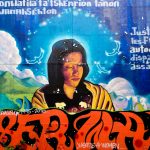Gender violence: From grief to rupture to movement
High rates of femicide make South Africa one of the most dangerous places to be female. With the government failing to protect women, it’s time for a movement that will change the status quo.
Author:
19 June 2020

A large chunk of Roberto Bolaño’s 2666 – his almost 900-page novel that was published in 2004, a year after his death – consists of relentless, forensic report-style accounts of the murders of women and girls in a fictionalised version of Mexican border town Ciudad Juárez.
Bolaño details 112 murders over a five-year period. Mutilated bodies turn up in the desert. They’re often never identified and arrests are seldom made. There’s no real sense of why this horror is unfolding. No meaning is given to the accumulation of bodies.
This is fiction that reads like an account of the actual horrors taking place in Ciudad Juárez in the 1990s. A report published in early 2005 lists more than 370 murdered women and girls. They were mostly workers in the town’s maquiladoras, or American-owned factories.
Related article:
Bolaño’s attempt to generate a fictional record of the murders of people whose lives society generally treats as disposable is a harrowing literary intervention. Reading it is exhausting and painful, and raises profound questions about how some lives come to be counted as expendable.
Mexico is not the only country in which women and girls are murdered, often in ritualised forms of sadism, at a terrifying scale. South Africa is counted with countries such as El Salvador, Russia and Jamaica as one of the most dangerous societies on the planet in which to inhabit a female body.
Here, as in India, there are brief moments of collective grief and outrage when a murder captures public attention. But then the usual flow of life resumes and the relentless murders drop into the background of a society in which the scale of everyday brutality is simply too much to bear.
Constant threat
Our state murders people on a staggering scale. We murder each other in our homes and on the streets. We periodically form mobs and attack migrants. Whole categories of people are treated as less than fully human, as disposable, by significant factions of the state and society. If you are impoverished, queer, trans, a migrant, a sex worker, a grassroots political activist or a woman, you live with the constant awareness of the threat to your life.
South Africa is, like Mexico, El Salvador and many other societies, what Frantz Fanon described as “a non-viable society, a society to be replaced”. The gulf between our lived reality and our highest aspirations, generated in struggle and sometimes written into law, is not only vast, it is also widening.
We come from a brutal colonial past, from a history of organised dehumanisation. By the time Jacob Zuma was deposed from the presidency, the ANC was a violent and predatory organisation, a necropolitical machine that enriched its leaders while engaged in systemic violence against impoverished black people. It was wholly unable to meet the profound social and political challenges carried into the present from our colonial past.
Zuma may be gone, but the party remains unable to meet even the most basic needs of millions of people. It continues to enable figures like Bheki Cele, Fikile Mbalula and others who actively advocate for state violence as a response to widespread impoverishment and trauma.
Related article:
As in the United States, Brazil and many other countries, our criminal justice system actively continues the cycle of violence and dehumanisation into the present. Police stations are often sites of abuse. Our prisons are places of horror rather than healing.
At the moment, there is little prospect that the state will undertake effective intervention into the crisis of violence against women and girls. A sober reading of the situation indicates that if we are to have any real chance of breaking the cycle of abuse, the energies and organisation required will have to come from society.
The rapid gains and global impact of the rebellion that swept the US following the police murder of George Floyd show what genuinely popular action can achieve. In South Africa, it has enabled a conversation about police violence that was not previously possible.
Women’s resistance
A similar movement against gendered violence is entirely possible. Before the Covid-19 lockdown, there were already impressive developments under way in much of the Spanish-speaking world. On 8 March 2020, more than a million women rallied in support of women’s rights across Chile. In Mexico, on the same day, tens of thousands of women went on strike in protest at violence against women and girls. Organisers explained that the absence of women from work and public spaces was intended as a reminder that, every day, 10 women are killed and disappear forever in Mexico.
The women’s strike in Mexico, which made headlines around the world, followed earlier action in Spain. On 8 March 2018, millions of women were reported to have gone on strike in support of women’s rights in the country. Organised by trade unions and women’s organisations, huge numbers of women refused both paid labour in the workplace and unpaid labour in the home.
Related article:
These kinds of actions, driven by popular rather than non-governmental organisation feminism, have continued during the lockdown. On 1 June, thousands of women across Argentina defied regulations to protest against the murder of 57 women during that country’s coronavirus lockdown.
Our condition is heartbreaking, our news cycle as harrowing as Bolaño’s novel. But the growing refusal to accept the disposability of the lives of women and girls that is sweeping the Spanish-speaking world is heartening. We, too, need a moment of militant collective refusal of this non-viable society, and an affirmation of an alternative. We need a moment of rupture that leads to a movement with enough power to break what needs to be broken and build what needs to be built.



